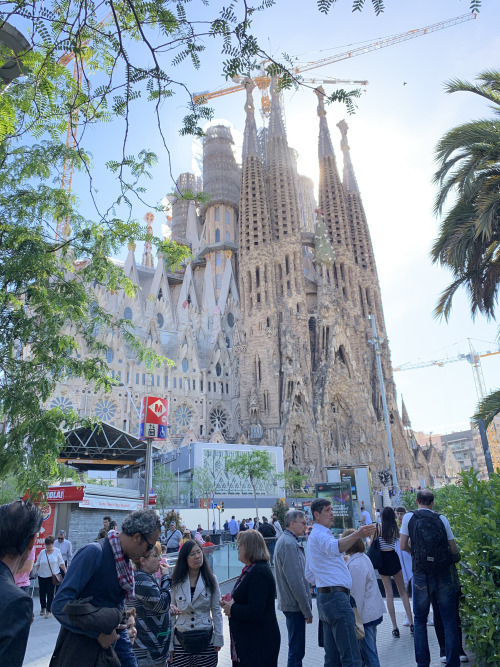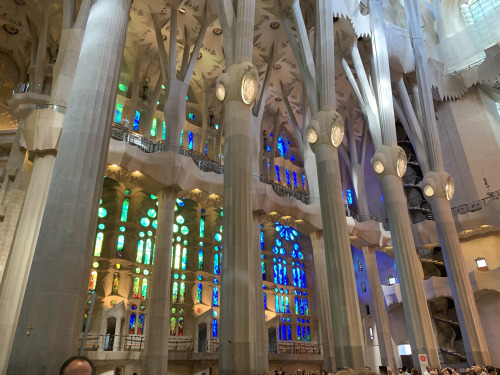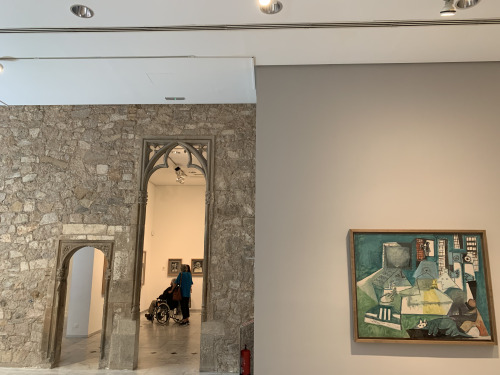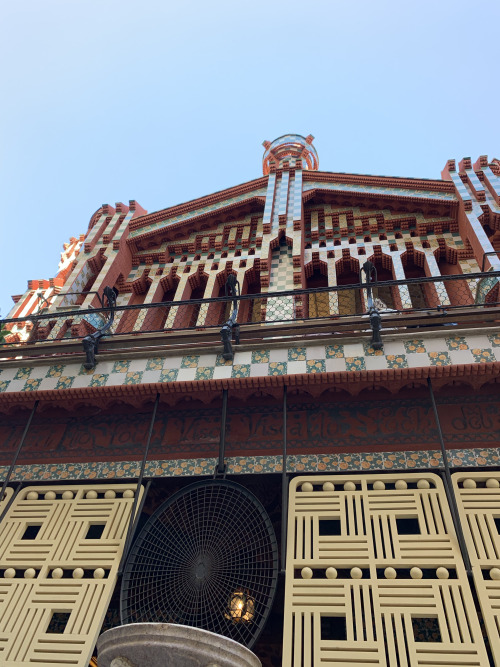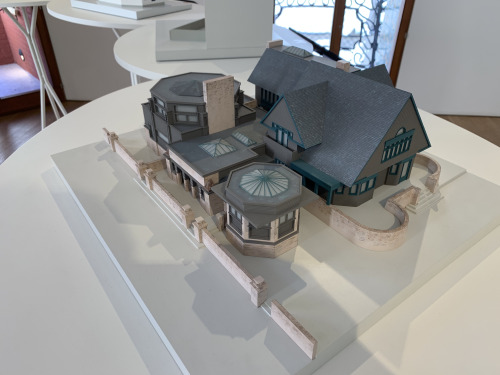A couple of days ago, the group visited the House of European History museum. Before entering, Dean Royster treated us all to a delicious lunch in the museum café. She and her husband also went through the museum with us. The museum is a very interactive museum, with tablets to carry and audio guides in the language of your choice.
The first exhibit is their temporary exhibit on what it was like to be a youth (18-27) in different decades of Europe’s recent history. It started with a punk room, including a bedroom decorated how a punk would have, with music, posters, and a spiked jacket. It explained the youth movement and protests, which primarily occurred due to their age group having very little job security. Next, there is a room about the Free Love ideals and AIDS discovery and awareness. This room interestingly had a board game about AIDS! The next room is decorated to look like a teenage girl’s bedroom in the 80’s, complete with scrunchies, a jean jacket, and a tiny square television playing MTV. It also had an interactive spot, where museum-goers could decorate buttons in the style of the 80s. The final room is about our generations- millennials and Gen Z. There is information about social media, politics, and current youth protests in countries across Europe. There is also a mini exhibit about the Schengen Area, which we studied! At the end, there is an interactive spot at which museum-goers could design a protest poster or type a Twitter-esque thought to be permanently displayed in the exhibit.
On the next floor begin the permanent exhibitions. This floor is titled, “Shaping Europe,” and is primarily about pre-19th-century Europe. It contains an exhibit on mapping Europe and the difficulties faced by ancient and modern cartographers (Where does Europe end and Asia begin?), a video about Europa and the overarching trends of an ever-changing Europe, and many bits and pieces of European heritage, history, and memory, including philosophy, slavery, and colonialism. It was very interesting to see items from Ancient Greek times next to a copy of Anne Frank’s diary. As museum-goers walked, their audio guides explained the overviews of each exhibit, with an option to hear more about each piece.
The next floor is titled “Europe: A Global Power” and is full of artifacts, books, and art from the 19th and 20th century. The first thing museum-goers see is an IMAX-type video about European revolutions, starting with the French Revolution, and surrounded by copies of multiple countries’ constitutions. Next, there is a steam machine, with images from the working class perspective on one side, and images from an industrialist perspective on the other. This museum did a very good job of showing both sides of every issue and conflict, especially in the next section, which separates advances in science and technology on one side from colonialism and exploitation on the other, both viewed behind panels of glass, like a windowed tunnel.
The next floor, titled “Europe in Ruins,” is all about World War One, World War Two, and their consequences. It had an entire exhibit on the Nuremberg trials and the Universal Declaration of Human Rights, two things we studied in Metz! There is also a Holocaust, or Shoah, remembrance exhibit. One section, titled “The Harvest of Destruction,” showed the impact of such atrocities and catastrophes on the people involved in them, through photographs, letters, and personal items. It was chilling.
The floor above that, with the happier title “Rebuilding a Divided Continent,” showed us the worldwide lasting consequences of the two world wars, including a very interesting Cold War room. The Cold War room, again, showed both sides of the conflict equally, and contained artifacts, posters, and political cartoons from the United States on one side of the room, and from the Soviet Union on the other. Interestingly, the first picture on each side is of the respective side’s atomic bomb. American museums don’t show “the other side” as much, so it was very thought-provoking to see communist propaganda next to strikingly similar capitalist propaganda. This floor also contained “Creating Social Security,” one of the most interesting rooms in the museum. The first thing museum-goers see is a small-scale 3-dimensional model of an apartment interior from the 70s, mounted on the wall when they first walk in. This room also features a wall dedicated to the consumer of the decade, filled with products the average person might buy. In addition, there is an old VW Bug in the corner, and a dentist’s chair from before health care was publicly funded. This room culminates in an interactive desk that allows museum-goers to take a quiz to see whether their personal values align more with communism or capitalism. Also on this floor is a room dedicated to European integration, specifically Robert Schuman and his peers. This was very cool to see, as we’ve been studying their history and principles all summer!
The next floor is titled “Shattering Certainties,” and starts in the 70s with OPEC’s price increase and the resulting global energy crisis. In Europe, everyone’s day-to-day lives were affected because they were so dependent on imported energy. In many places, “No Car Sundays” were implemented, and awareness was raised about waste- hot on the heels of the consumerist lives many had been living. There is a room about democratization, specifically the 1970s revolutions across Europe (Greece, Spain, and Portugal), and the rise of feminism. The area right after that is about the decline of communism as it became more and more obvious that it never lived up to its promises, and that the people under communism suffered. There are more exhibits and artifacts about European integration, specifically the first direct elections for European Parliament, the movement towards a single market, a harmonization of European passports, and the Conference on Security and Cooperation in Europe (1975). There is an emotional exhibit on the redrawing of European borders, first with the fall of the Berlin Wall and reunification of Germany, and second with the Yugoslavian civil wars, ethnic cleansing, and subsequent split. There is also a room dedicated to how similar and unified European lives are becoming, modern views of the EU, and an intriguing exhibit on how “shared and divided” European memory is.
The final floor has three distinct sections. The first is about how Europe is and was viewed by those outside of Europe. This section contains pieces from museums about Europe. The second section is about accolades and criticisms the European Union, its members, and its neighbors have received. The third section is all about Brussels!
Overall, the House of European History was much more interesting, interactive, and stimulating than any of us could have imagined, and several of us will likely be going back, as it’s free!












